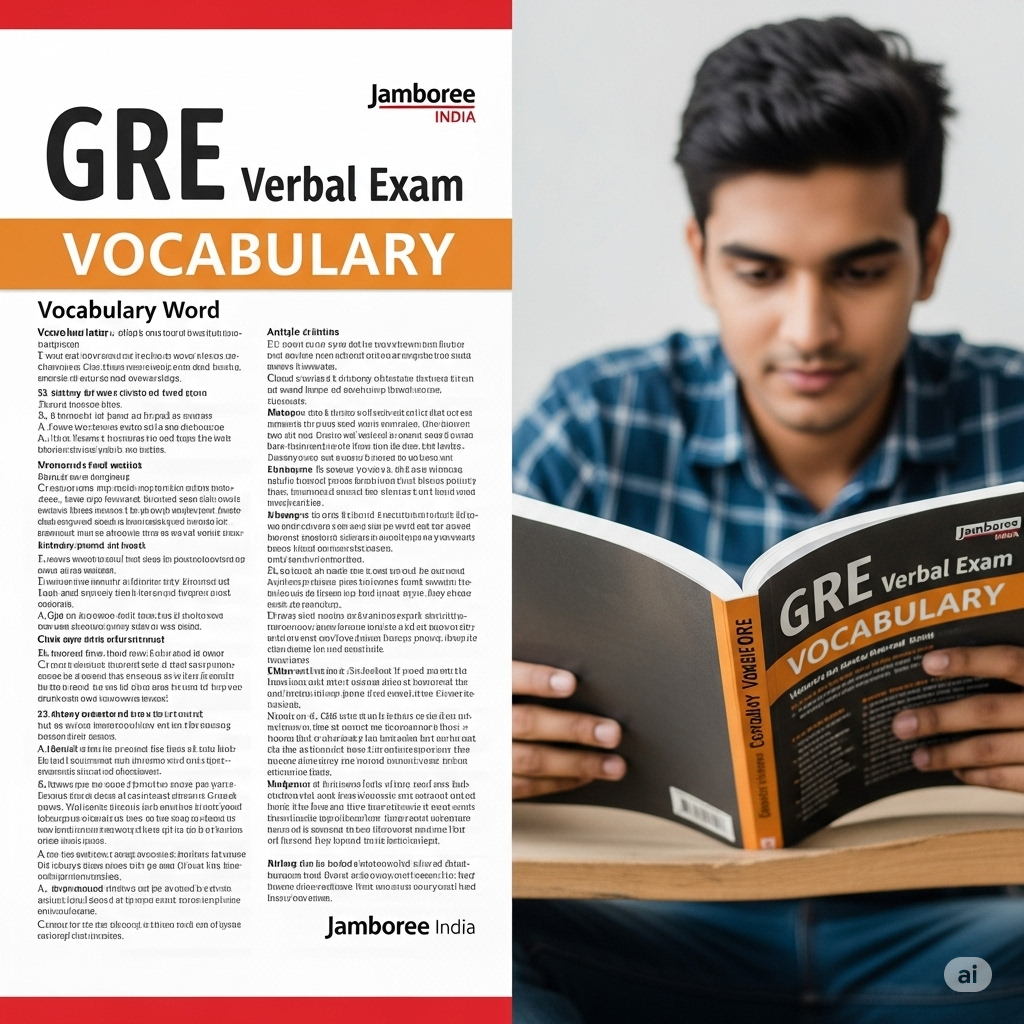It’s high time you get rid of the fear of GRE Verbal. Even if you’re not super proficient in English or your vocabulary is not that great, you can still get a good score. Learn the right approaches, practice regularly and you can easily master the Verbal part of the GRE exam. Even your biggest fears – long sentences, GRE Vocab or difficult reading comprehension passages – are not very big concerns and easily manageable, trust me!
Table of Contents
Text Completion and Sentence Equivalence Made Easy (even without vocab)
I’ll discuss some questions – specially that are marked ‘Medium and ‘Hard’ in GRE Official Guide’ – to show how you can crack GRE Verbal questions easily, sometimes even without knowing the meanings of all the words.
Look at this question.
At their best,_________ book reviews are written in defence of value and in the tacit hope that the author, having had his or her ________ pointed out, might secretly agree that the book could be improved.
(i) A abstruse B adverse C hortatory
(ii) D Strengths E transgressions F assumptions
This question is in the hard section in the GRE Verbal official Guide. Option A abstruse and Option C hortatory may not be known words. But look for a clue in the sentence. The sentence says that the book reviews indicate that ‘the book could be improved.’ Hence clearly they are negative or adverse reviews. So for the first blank your obvious choice is A Adverse. And negative or adverse reviews would not point out the book’s strengths. Neither would book reviews make assumptions. So clearly for the second blank the obvious choice is E Transgressions. This is how finding the right clue(s) in the sentence can help you to get your answers even without knowing the meanings of all the options.
Let’s check out another question.
The band’s long-standing strategy of laying leisurely explorations atop a steady funk beat has proven to be surprisingly__________: a concert in Cologne from 1972 sounds as if it could have taken place today.
A. fortuitous
B. foresighted
C. prescient
D. popular
E. serendipitous
F. lucrative
The first sentence of the question might be really daunting. What are ‘leisurely explorations?’ What is ‘a steady funk beat?’ But look at the second sentence – a 1972 concert sounds like a concert today. So we get the concert much ahead its time. So we choose the words B foresighted and C prescient. We need not even bother about the music related jargon in the first sentence.
So you see you can crack sentences sometimes without even knowing the meanings of some words or even understanding the entire sentence. Be mindful and find some clue in the sentence that leads you to your answer.

Long Sentences made easy
Look at the question below.
The company’s efforts to improve safety were apparently (i)_________, at least according to the company’s own data, which showed that the (ii)___________incidents with the potential to cause a serious accident declined signifcantly. Nevertheless, independent analysts argue that those statistics are (iii)__________Tese analysts maintain that the company has consistently underestimated both the probability and the likely effects of accidents in the sensitive and poorly understood environment in which the company is operating.
Blank (i)
| A. innovative |
| B. successful |
| C. frustrated |
Blank (ii)
| D. frequency of |
| E. impediments to |
| F. attention to |
Blank (iii)
| G. deceptive |
| H. testable |
| I. consistent |
Long sentence yes. Don’t freak out. Fish out the clues. In the first sentence we get ‘company’s own data.’ Company’s own data would of course show company in a positive light. Again we get ‘the potential to cause a serious accident declined.’ So clearly this data is trying to indicate that the company’s efforts to improve safety are successful. Clearly our we choose B successful. And of course D frequency of serious accident declined. But then we get the keyword ‘nevertheless’ which denotes contrast. Hence we can conclude the independent analysts are not agreeing with the company’s data. So clearly our third blank word is G deceptive.

Let’s crack another long sentence.
There is no point in combing through the director’s work for hints of ideological significance. It is unnecessary: his ideology—Marxist, anti-imperialist, aligned with the perceived interests of the powerless and the marginal—is the (i) ________ of his films. The clarity and force of that ideology are considerable, but its (ii) ________ sometimes bothers critics, who often scold the director for lacking (iii) ________.
| Blank i | Blank ii | Blank iii |
| a) hidden focus | d) bluntness | g) lucidity |
| b) chief impetus | e) obscurity | h) subtlety |
| c) murky lesson | f) feebleness | i) courage |
The sentence says there is no point in combing through that is searching. Hence we can think it’s not hidden or murky. It’s the B) chief impetus. It’s very obvious, hence there is no need to search it out. Now the second and third blank are talking about the ideology. The second blank is talking about what the ideology has – its ___, the third blank talks about what the ideology lacks. Hence we need a pair that works accordingly. For instance if the we think of ‘poverty’ for the second blank, clearly the third blank would say it lacks money. So we have two such pairs . If we choose ‘bluntness’ for the second blank, then clearly it lacks ‘subtlety’, or if the ideology has ‘obscurity’ then clearly it lacks ‘lucidity’. But the sentence has mentioned that the ideology has ‘clarity’, therefore we reject the pair obscurity/lucidity. So we choose d)bluntness and h)subtlety.
So don’t worry about long sentences. Look for keywords and clues and decode Text Completion in GRE Verbal.
Reading Comprehension Made Easy
We’ll now discuss a Reading Comprehension passage marked ‘hard’ in GRE Verbal Official Guide.
What causes a helix in nature to appear with either a dextral (right-handed, or clockwise) twist or a sinistral (left-handed, or counterclockwise) twist is one of the most intriguing puzzles in the science of form. Most spiral-shaped snail species are predominantly dextral. But at one time, handedness (twist direction of the shell) was equally distributed within some snail species that have become predominantly dextral or, in a few species, predominantly sinistral. What mechanisms control handedness and keep left-handedness rare?
It would seem unlikely that evolution should discriminate against sinistral snails if sinistral and dextral snails are exact mirror images, for any disadvantage that a sinistral twist in itself could confer on its possessor is almost inconceivable. But left- and right-handed snails are not actually true mirror images of one another. Their shapes are noticeably different. Sinistral rarity might, then, be a consequence of possible disadvantages conferred by these other concomitant structural features. In addition, perhaps left- and right-handed snails cannot mate with each other, having incompatible twist directions. Presumably, an individual of the rarer form would have relative difficulty in finding a mate of the same hand, thus keeping the rare form rare or creating geographically separated right- and left-handed populations.
But this evolutionary mechanism combining dissymmetry, anatomy, and chance does not provide an adequate explanation of why right-handedness should have become predominant. It does not explain, for example, why the infrequent unions between snails of opposing hands produce fewer offspring of the rarer than the commoner form in species where each parent contributes equally to handedness. Nor does it explain why, in a species where one parent determines handedness, a brood is not exclusively right- or left-handed when the offspring would have the same genetic predisposition.
In the European pond snail Lymnaea peregra, a predominantly dextral species whose handedness is maternally determined, a brood might be expected to be exclusively right- or left-handed—and this often occurs. However, some broods possess a few snails of the opposing hand, and in predominantly sinistral broods, the incidence of dextrality is surprisingly high.
Here, the evolutionary theory must defer to a theory based on an explicit developmental mechanism that can favor either right- or left-handedness. In the case of Lymnaea peregra, studies indicate that a dextral gene is expressed during egg formation; i.e., before egg fertilization, the gene produces a protein, found in the cytoplasm of the egg, that controls the pattern of cell division and thus handedness. In experiments, an injection of cytoplasm from dextral eggs changes the pattern of sinistral eggs, but an injection from sinistral eggs does not influence dextral eggs. One explanation for the differing effects is that all Lymnaea peregra eggs begin left-handed but most switch to being right-handed. Thus the path to a solution to the puzzle of handedness in all snails appears to be as twisted as the helix itself.
The second paragraph of the passage is primarily concerned with offering possible reasons why
A) it is unlikely that evolutionary mechanisms could discriminate against sinistral snails
B) sinistrality is relatively uncommon among snail species
C) dextral and sinistral populations of a snail species tend to intermingle
D) a theory based on a developmental mechanism inadequately accounts for the predominance of dextrality across snail species
E) dextral snails breed more readily than sinistral snails, even within predominantly sinistral populations
So the question is asking for the answer the second paragraph is giving to a certain ‘why’ that is a certain question. If we notice the first paragraph is indeed ending with a question.The question is what mechanism controls handedness and keeps left handedness rare. Clearly we can expect the second paragraph would answer this question and tell us about that mechanism. Now let’s notice the beginning of the third paragraph , ‘This evolutionary mechanism.’ So the second paragraph is talking about the evolutionary mechanism and therefore answering the question in the last sentence of the first paragraph. So our answer is B – why sinistrality or left handedness is rare.
Now, another question from the same ‘hard’ passage.
Which of the following accurately describes the relationship between the evolutionary and developmental theories discussed in the passage?
A) Although the two theories reach the same conclusion, each is based on different assumptions.
B) They present contradictory explanations of the same phenomenon.
C) The second theory accounts for certain phenomena that the first cannot explain.
D) The second theory demonstrates why the first is valid only for very unusual, special cases.
E) They are identical and interchangeable in that the second theory merely restates the first in less technical terms.
The question is asking about the relationship between the two theories. We’re getting the relationship in the last paragraph beginning – “Here the evolutionary theory must defer to . . .’ So clearly our answer is C.
So, the point is don’t worry. GRE Verbal is totally manageable if you follow the right approach, practice and be mindful. Although Vocab is important and you need to study Vocab, sometimes it’s possible to decode a Text Completion or Sentence Equivalence question even if you do not know the meanings of some words or do not understand the sentence fully. You need to focus on finding the right keywords and clues. Also, you can crack Reading Comprehension where Vocab is not necessary and you can crack the questions going back to the relevant location in the passage.
GRE is the first step towards reaching your dream college and embracing your dream life and career. Let the hope and dream win over the fear. Have faith in your ability and honest efforts. Trust me GRE Verbal is totally doable, if not low-key easy.



